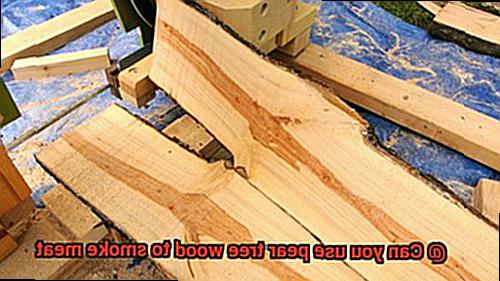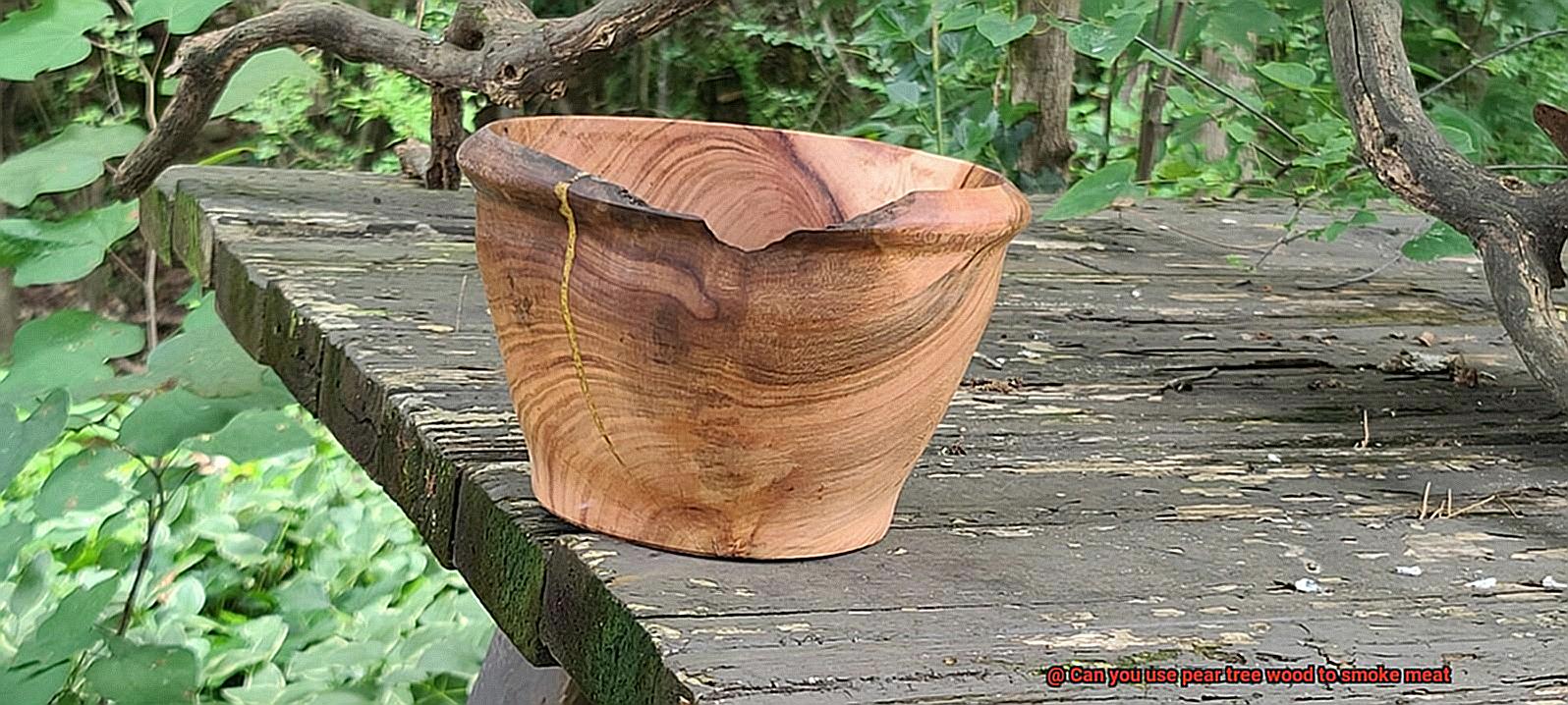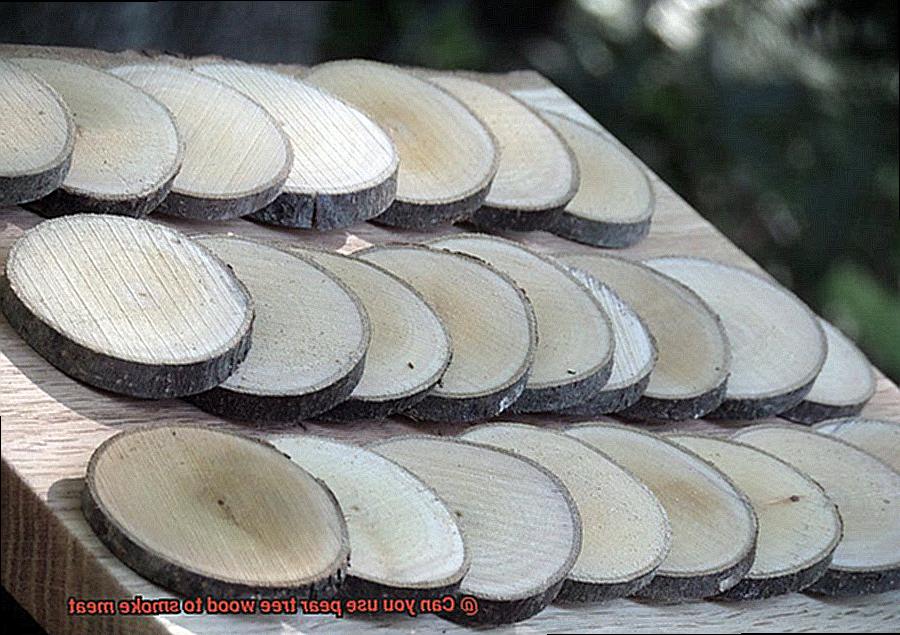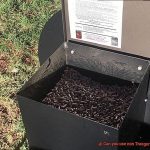Imagine this: it’s a lazy Saturday afternoon, and you’re itching to fire up the smoker for some juicy brisket or melt-in-your-mouth ribs. You know that the type of wood you use can make or break your dish’s flavor profile. But what if you have a pear tree in your backyard? Can you use its wood to add a unique taste to your meat?
While most people think of apple or cherrywood when it comes to fruitwood, pear tree wood is a surprisingly tasty option for smoking meats. It imparts a subtle sweetness and burns slowly, making it perfect for low and slow smoking.
But don’t go hacking at your pear tree just yet. Not all pear tree wood is suitable for smoking meat. You need to ensure that the wood has been properly seasoned, dried, and free from any harmful chemicals.
In this post, we’ll delve deeper into using pear tree wood for smoking meat. We’ll explore why it’s an excellent choice, how to prepare and use it correctly, and what dishes will benefit from its unique flavor. Get ready for a culinary adventure with pear tree wood.
Contents
What is Pear Tree Wood?
Pear tree wood is perfect for smoking meat due to its sweet flavor and aroma. But what exactly is pear tree wood, and why is it such a popular choice?
Pear tree wood comes from the pear tree, which can grow up to 40 feet tall in temperate regions. It’s known for being dense and heavy, making it ideal for smoking meat. When freshly cut, the wood has a light yellowish-brown color, but as it ages, it darkens to a rich reddish-brown. This color change is due to oxidation and aging, but don’t worry – it doesn’t affect the flavor or quality of the wood.
One of the unique aspects of pear tree wood is its versatility in smoking different types of meat. It pairs well with pork, chicken, turkey, and fish, making it a great option for those who enjoy variety in their smoked meats. Plus, it can be combined with other woods like hickory or mesquite to create even more unique flavor profiles.
But before you start smoking with pear tree wood, make sure you properly season it. Freshly cut wood has too much moisture, which can produce a bitter smoke that ruins the flavor of your meat. Let the wood dry for at least six months in a dry and well-ventilated area before using it.
When smoking with pear tree wood, it produces a beautiful color on the meat that’s sure to impress your guests. However, not all varieties of pear trees are created equal when it comes to smoking meat. Some produce better smoking wood than others, so do some research before selecting the type of pear tree wood you want to use.
Benefits of Using Pear Tree Wood for Smoking Meat
Its subtle sweetness and aroma add a unique and delicious flavor to your meat, while its many benefits make it a must-try for any pitmaster. Let’s explore the remarkable benefits of using pear tree wood for smoking meat.
Firstly, pear tree wood has a mild, sweet flavor that perfectly complements the natural taste of meat without overpowering it. This means that you can smoke a variety of meats with pear wood, from beef to chicken and fish, without worrying about the flavor being too strong or overwhelming.
Secondly, pear wood has a high smoke density, producing thick smoke that penetrates deep into the meat. This infusion of flavor and aroma is ideal for slow-cooking methods such as smoking, where you want the smoke to linger around the meat for an extended period. With pear tree wood, your meat will be infused with a rich and delicious smoky flavor.
Thirdly, pear trees are widespread in many parts of the world, making it easy to find and source the wood. Additionally, compared to other types of smoking woods, pear tree wood is relatively affordable, so it’s an excellent option for those on a budget. You won’t have to break the bank to enjoy the delicious flavors of smoked meat.
Fourthly, pear tree wood burns cleanly and produces little ash, making it easy to control the temperature and maintain a consistent heat level while smoking meat. This is crucial when smoking meat for extended periods because you want to ensure that the temperature remains stable throughout the cooking process. With pear tree wood, you can rest assured that you’ll get perfectly cooked meat every time.
How to Select the Right Variety of Pear Tree Wood
Smoking meat is an art that requires the right kind of wood to achieve the perfect flavor. Pear tree wood is a popular choice, but not all pear tree wood is suitable for smoking. To select the right variety of pear tree wood for smoking meat, consider these five sub-sections.
Choose the Right Species
The first and most crucial step is to select the right species of pear tree. While all pear trees produce fruit, not all are suitable for smoking. European pear trees are a popular choice because they produce a sweet and mild smoke flavor that pairs well with pork, chicken, and fish. On the other hand, Asian pear trees produce a slightly stronger smoke flavor that works well with beef and lamb.
Consider the Age of the Wood
The age of the pear tree wood can also affect the smoke flavor. Younger trees produce a lighter and more delicate smoke flavor, while older trees yield a stronger and richer flavor. Keep this in mind when selecting your pear tree wood.
Check the Moisture Content
The moisture content of your pear tree wood is critical to producing a consistent burn and smoke output. Pear tree wood should be seasoned for at least six months to a year before use to allow excess moisture to evaporate. This results in a cleaner and more consistent smoke flavor.
Avoid Treated Wood
It’s essential to avoid using any pear tree wood that has been treated with chemicals or pesticides. This can not only affect the flavor of your meat but also pose health risks.
Look for Quality Pieces
When selecting your pear tree wood, look for pieces that are free of knots and other imperfections. These can cause uneven burning and inconsistent smoke production, which can negatively impact the overall flavor of your meat.
Preparing and Seasoning Pear Tree Wood for Smoking

Smoking meat is more than just cooking food; it’s a way of producing a unique and delicious flavor that elevates any dish to the next level. When it comes to smoking, pear tree wood is an excellent choice as it provides a mild and sweet flavor that complements poultry, pork, and fish perfectly. However, the key to achieving this perfect taste lies in preparing and seasoning the pear tree wood correctly.
The first step in preparing pear tree wood for smoking is to select only healthy and mature pear trees. Young or diseased trees may contain harmful chemicals or sap that can negatively impact the taste of your meat. Once you’ve gathered your wood, the next step is to dry it out for at least six months to a year. This process allows the wood to reach an optimal moisture level of around 20 percent, which is crucial for efficient combustion and smoke production.

After the wood has dried, it’s time to cut it into small pieces suitable for use in a smoker or grill. It’s essential to remove any bark or debris from the wood as this can cause uneven burning and affect your meat’s flavor.
Now comes the exciting part – seasoning your pear tree wood. The best way to do this is by coating the wood with a dry rub or marinade consisting of salt, sugar, garlic, and other spices. Leave it to sit for several hours or overnight to allow the flavors to penetrate the wood fully.
To ensure your safety when smoking meat, avoid using treated wood as it can release harmful chemicals when burned and negatively impact your meat’s taste. Additionally, inspect your prepared pear tree wood for any imperfections that may cause uneven burning and affect your meat’s flavor.
Different Types of Smokers Suitable for Use with Pear Tree Wood
Smoking meat with pear tree wood is a great way to add a unique and delicious flavor to your dishes. However, the type of smoker you use can make all the difference in the final outcome. Here are five different types of smokers that are suitable for using with pear tree wood:
Offset Smokers
These smokers have a separate firebox where you can burn your pear tree wood, allowing the smoke to flow into the main chamber where your meat is located. This type of smoker provides a traditional smoky flavor and allows for precise temperature control. The long, horizontal design of offset smokers also provides plenty of space for smoking large cuts of meat.
Pellet Smokers
These smokers use compressed wood pellets as fuel and are designed to work with fruitwood pellets, including pear tree wood pellets. They are easy to use and maintain consistent temperatures, making them a great option for beginners. Some pellet smokers even come with digital controls that allow you to set the temperature and smoke level precisely.
Electric Smokers
These smokers use electricity to heat up wood chips or chunks, creating smoke to flavor your meat. While they lack the traditional smoky flavor of offset smokers, they are easy to use and provide consistent results. Electric smokers are also more affordable than some other types of smokers, making them a great choice for home cooks on a budget.
Drum Smokers
These smokers feature a large drum-shaped chamber where you can burn your wood, providing ample room for smoking large cuts of meat like brisket or pork shoulder. Drum smokers typically have a simple design and are easy to use, making them a popular choice among backyard pitmasters. They also tend to be more affordable than some other types of smokers.
Gas Smokers
Gas smokers use propane or natural gas as their heat source and come with a built-in smoke box for adding wood chips or chunks. While gas smokers may not produce as rich of a smoke flavor as other types of smokers, they are convenient and easy to use. They are also great for smoking meats quickly, making them a good option for busy weeknights.
Combining Different Woods for a Complex Flavor Profile
Smoking meat is not just a cooking technique; it’s an art form. The right type of wood can infuse a depth of flavor that tantalizes the taste buds and creates a truly memorable culinary experience. But what if you could take that experience to the next level by combining different woods? Welcome to the world of complex flavor profiles.
One wood that deserves consideration when blending is pear tree wood. Its mild and sweet flavor profile makes it an ideal candidate for smoking poultry, pork, and fish. And while it produces a subtle smoke, pairing it with other types of wood can result in an explosion of flavor.
One option is to use pear wood as a complement to stronger woods such as hickory or mesquite. This combination adds depth and complexity without overwhelming the meat’s natural taste. The result is a smoky sweetness with just enough kick to keep things interesting.
Another option is to pair pear wood with fruitwoods like apple or cherry. This combination creates a sweet and fruity smoke that complements pork and poultry to perfection. It’s like having dessert with your main course – pure culinary bliss.
But remember, not all woods are created equal. Each one has its own unique flavor profile, burn time, and smoke intensity. Experimenting with different wood combinations is essential to finding the perfect blend that suits your taste preferences.
Tips and Tricks for Perfectly Smoked Meat with Pear Tree Wood
Smoking meat with pear tree wood can elevate your BBQ game to the next level. But how do you ensure that your meat is perfectly smoked with pear wood? Here are some tips and tricks to help you achieve that mouth-watering flavor and texture.
Choose the Right Wood
The first step to smoking meat with pear tree wood is selecting the right wood. Ensure that the wood is well-seasoned, dried for at least six months, and cut into suitable sizes. This will ensure that the wood burns evenly and produces a consistent smoke throughout the smoking process.
Control the Temperature
Maintaining a consistent temperature throughout the smoking process is crucial. Use a digital thermometer to monitor the temperature inside your smoker and adjust the heat accordingly. Smoking meat with pear wood requires a lower temperature for a longer period of time. This will allow the smoke to infuse into the meat slowly and evenly, resulting in a tender and flavorful final product.
Use the Right Amount of Smoke
Pear wood can produce a lot of smoke, so it’s important to monitor the amount of smoke being produced and adjust as needed. Too much smoke can result in an overpowering flavor and can even cause the meat to become bitter. On the other hand, too little smoke can result in an underwhelming flavor. Find the right balance for your taste buds by experimenting with different amounts of smoke.
Add Flavor with Marinades and Rubs
While pear wood adds a sweet and mild flavor to your smoked meat, marinades and rubs can enhance its taste even further. When using marinades, make sure to marinate the meat for at least 6 hours before smoking it. Rubs are applied directly to the meat before smoking and can add a delicious crust to the outside. Experiment with different flavors to find your perfect combination.
Let the Meat Rest
After smoking, let the meat rest for at least 10 minutes before slicing it. This allows the juices to redistribute, resulting in a more tender and flavorful meat. Resist the temptation to cut into your smoked meat right away, as this can cause the juices to escape and leave you with a dry and tough final product.
e_ihPPARY9A” >
Conclusion
In conclusion, pear tree wood is an excellent choice for smoking meat if you want to add a unique and delicious flavor to your dishes. Its mild and sweet taste profile makes it perfect for smoking poultry, pork, and fish. However, not all pear tree wood is created equal when it comes to smoking meat. You must ensure that the wood has been correctly seasoned, dried, and free from any harmful chemicals.
One of the best things about using pear tree wood is the beautiful color it produces on the meat. Your guests are sure to be impressed. Additionally, this type of wood burns cleanly and leaves behind minimal ash, making it easy to maintain a consistent heat level while smoking your meat.
When selecting which variety of pear tree wood to use for smoking meat, there are several factors to consider. These include choosing the right species, checking the moisture content, avoiding treated wood, and looking for quality pieces.
Experimenting with different combinations of woods is essential when trying to find the perfect blend that suits your taste preferences. By controlling the temperature, using the right amount of smoke, adding flavor with marinades and rubs, and allowing your meat time to rest before serving – you can achieve perfectly smoked meat with pear tree wood.






